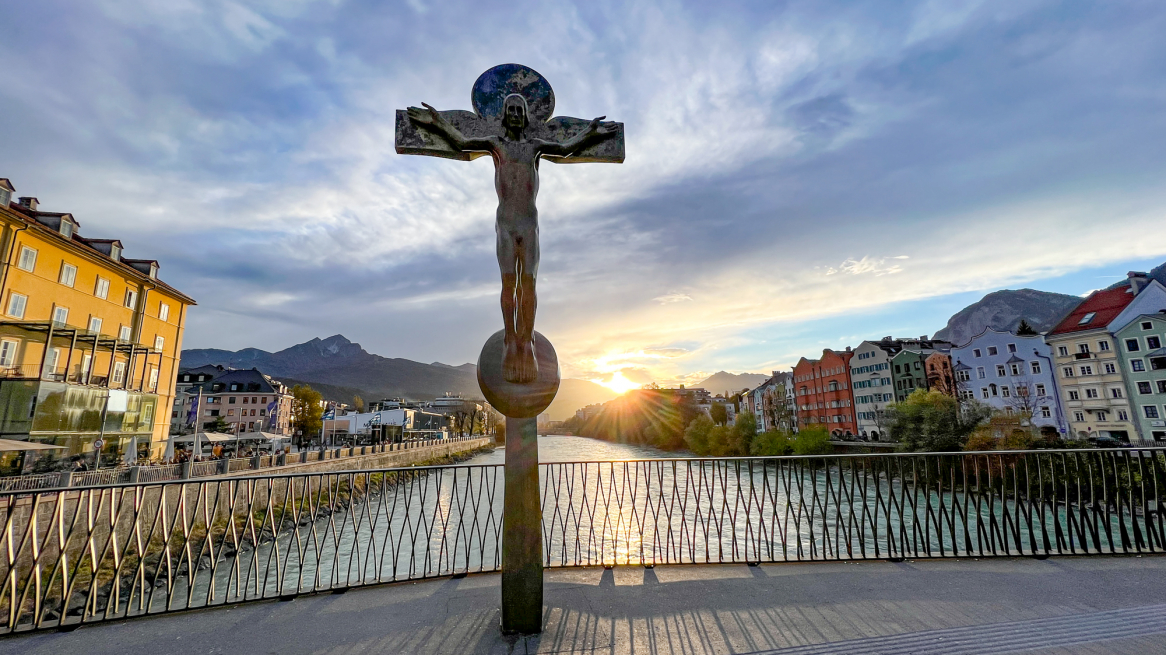
Anton Prock collects stories. As an art historian, that's hardly surprising. But the fact that he can also tell them well makes the man exciting. The matter becomes really fascinating when one knows that the good man can also be a tourist guide, a school principal for twenty years, and even a few good books. These days, his latest companion book - for Innsbruck city walks - was published by the local Tyrolia publishing house.
Step by step city history
The small Tyrolean capital virtually lends itself to the inclined walker: Here, promenades line the river, there the seasons play in the city garden, and as soon as it gets steeper on the meadow paths, hiking trails lead into the forest. But it's not just nature that entices visitors on a voyage of discovery; the city itself has plenty to show and tell. And so the publisher and author of the Innsbruck City Walks recently invited visitors to a book presentation of a somewhat different kind.
In front of the memorial plaque at the Tyrolia bookstore, Anton Prock opens his little blue book and reads - how Diana Obexer, a native of Innsbruck, once rescued several thousand children from Croatian concentration camps. The short reading transforms what seemed to me to be a completely unremarkable place into a weighty milestone in history, right in the middle of the vibrant Maria Theresien Strasse. An entire chapter is devoted to Innsbruck's dapper boulevard, and behind the shop windows and stucco facades, it finds pages of treasures to tell about.
Schachtelwirt to city fountain
The Rose Prince by Hans André.
The city fountain near the city tower.
The teacher during the reading.
Scenes from the town square, corner Seilergasse.
Only briefly the author touches on some stories - Annasäule, town hall galleries and Spitalskirche, but also the new objectivity of the 1920s, which the Tyrolean artist Hans André also captured in numerous frescoes in the old town of Innsbruck. Thus we find ourselves at the Rosenhaus (Herzog-Friedrich-Strasse 39) in Chapter 20 under his prominent Rose Prince of 1952, which I had also never noticed so consciously. Only a little further on, the Gothic promenade vault next to the contemporary Schachtelwirt (McDonald's) is adorned with the quaternion eagle - to the horror of all city guides: With wild contortions, a total of 60 coats of arms and heraldic symbols have to be explained here - unless you simply look into the book, Professor Prock smiles. A few words follow on the eight public Innsbruck city fountains and their weighty task as a "social media platform" for daily washing and chatting - the "activities on the city square" are immortalized, by the way, only a little further on in illustrations on the Katzung House.
One thing leads to another
We finally find ourselves in the city tower (with Welsch hood) for the actual book presentation and are also finally allowed to leaf through the narrative companion work for Innsbruck city walks ourselves. My fears are confirmed: Here one thing leads to another and on to the next - one quickly gets lost in the pages. Cleverly, when handled correctly, walking and reading then alternate, so that looking and marveling are not neglected either. Here you have an inscription, there a fresco, there a coat of arms - already the selection of the narrative fixed points posed certain challenges, laughs the retired teacher. If you know a lot, you can tell a lot: Easy to read, short chapters, well-sorted focal points - the author's scholastic background is reflected benevolently in the accessibility and preparation of his walking work. If you want to make up your own mind, you can even get a free reading sample here.
Innsbruck: bridge and cross
Thus, in the town tower, we also learn about the life and work of the watchmen, who had to work 18 hours in summer and 16 hours in winter. If danger was imminent, the storm bell was rung, and in case of fire a lantern was placed in the window facing the direction of the fire. Historical records in the Innsbruck city archives, however, complain about the loose work ethic and probably also persistent drunkenness among the tower guards. When I finally stumble down the steep steps of the city tower with my new book, I can't help but think of the drunken tower guards who once regularly rolled down here. On these steps I will now probably always have to smile knowingly - another story. In front of the city tower the city music Saggen plays just a spontaneous brass concert, Innsbruck knows on the way really to reward. On my way home to St. Nicholas, I encounter the Wach-Kreuz on Innsbruck's oldest bridge, as always. This time, however, I stop, open the Innsbruck City Walks and let it tell me.
Photos, unless otherwise indicated: © Christian Weittenhiller
Rate this article
Show me the location on the map
A small "scribbler" with huge passions. Born, raised and refined in Tyrol. Loves to read and can cook almost as well as his grandma. At his happiest when out and about and searching for new horizons.
Similar articles
The museum in Innsbruck's Arsenal "Museum im Zeughaus" was reopened on April 6,…
The Ferdinandeum regional museum is open until June 30, 2024, with exhibitions and events. Then a…
A purely Tyrolean film project aims to shed new light on the novel story of probably…
With the Alpine Jitterbugs, Innsbruck has a club that is passionately dedicated to swing dancing. The Alpine…












